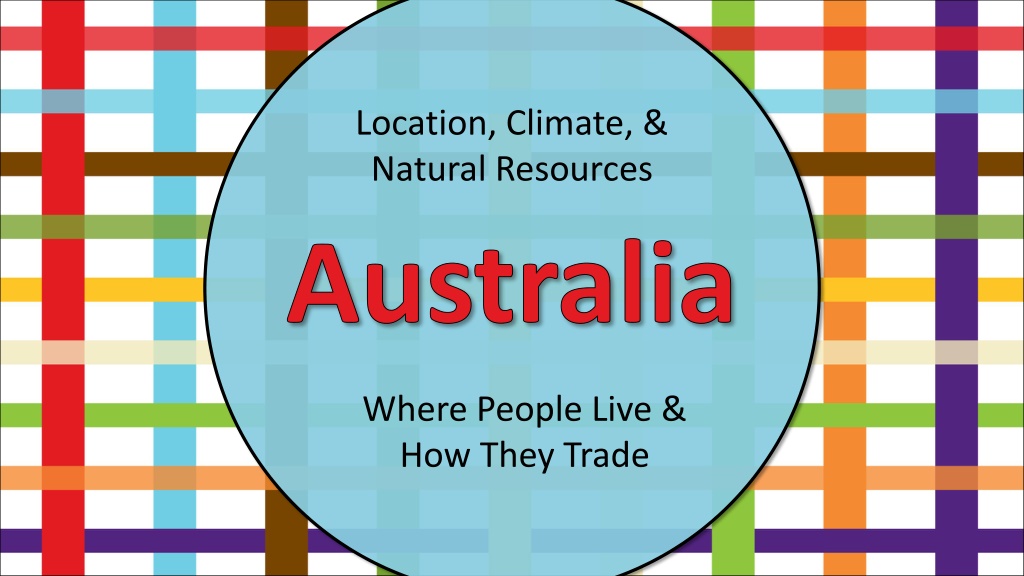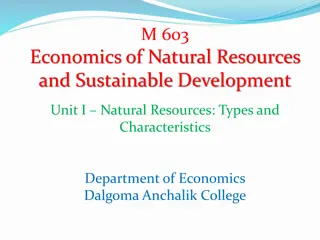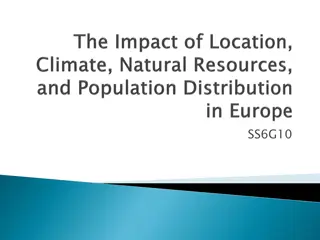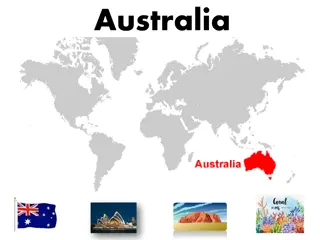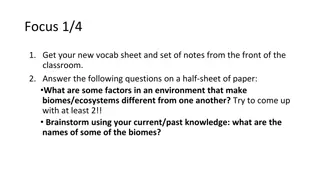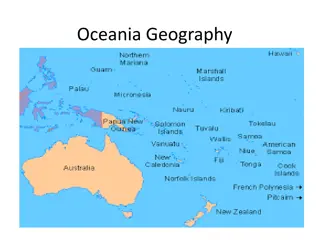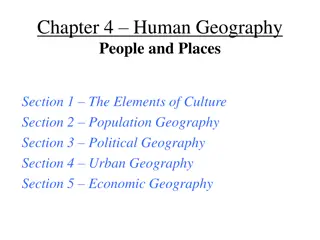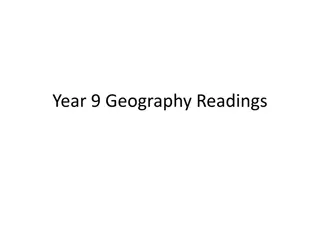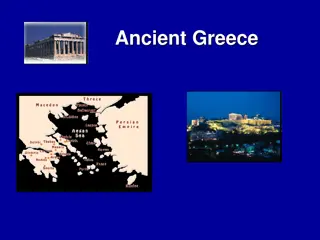Exploring Australia's Geography: Location, Climate, and Natural Resources
Australia, a unique continent and country, is surrounded by the Pacific and Indian Oceans. Its diverse climate ranges from tropical in the north to desert in central regions. The distribution of natural resources and population is influenced by these geographic factors, impacting where people live and how trade occurs in the country.
- Australia Geography
- Climate Diversity
- Natural Resources Distribution
- Population Impact
- Trade Patterns
Download Presentation

Please find below an Image/Link to download the presentation.
The content on the website is provided AS IS for your information and personal use only. It may not be sold, licensed, or shared on other websites without obtaining consent from the author. Download presentation by click this link. If you encounter any issues during the download, it is possible that the publisher has removed the file from their server.
E N D
Presentation Transcript
Location, Climate, & Natural Resources Australia Where People Live & How They Trade
Standards SS6G13 The student will explain the impact of location, climate, distribution of natural resources, and population distribution on Australia. a. Describe how Australia s location, climate, and natural resources have affected where people live. b. Describe how Australia s location, climate, and natural resources impact trade.
Location, Climate, & Natural Resources Australia Where People Live & How They Trade
Location Australia is both a continent & a country. It lies about 2,000 miles southeast of Asia. It s surrounded by the Pacific Ocean on the east and the Indian Ocean on the west. It s in the southern hemisphere. Literally the land down under !
Climate The climate varies across the continent. Australia is south of the equator, so it s climate is opposite that of North America. Summer: December through March Winter: June through September
Climate The northern part of Australia is closest to the equator. It has a tropical climate and is warm-to-hot all year round. It gets more rain than any other part of the country. Winter: wet and cool Summer: hot and dry
Climate Central Australia is mostly desert. This is the largest part of Australia. Very little rain falls here. Most of this area gets less than 10 inches of rain per year!
Climate Only the southeast and southwest corners along the coasts have a temperate climate. Summers aren t too hot & winters aren t too cold. The climate in these regions is the one that most Australians prefer. Most Australians live along southeastern coast.
Tourism Tourists from the northern hemisphere visit Australia s warm beaches when it s winter in their country. Tourists usually wait until spring or fall to visit the rural areas and the outback. It s not too hot then.
Natural Resources Outback refers to the dry interior of Australia. It s mainly open countryside, including vast expanses of grazing land. There are only a few widely scattered settlements in the Outback. Many of them grew up around mining operations.
Natural Resources Across much of Australia, the ground is barren & not ideal for farming (outback). Many minerals are found here: gold, silver, uranium, coal, copper, & iron ore Australia has exported nearly $400 billion worth of metals, minerals, & fuels in the past 20 years. Natural resources account for 1/3 of the country s economy!
Natural Resources Australia exports more coal & iron ore than any other country. It leads the world in mining bauxite, titanium, & diamonds. No other country has more reserves of lead, cadmium, or nickel.
Natural Resources Natural resources have always been important to Australian trade. In the mid-1800s, Australia had a gold rush in the southern region. Thousands of immigrants moved to Australia to find gold. Many came from England, Ireland, Germany, & China.
Natural Resources In the non-desert regions, Australians grow many grains. Grains are grown in inland regions of the coastal states (not too hot/dry here). Grains include a wide range of different crops: Wheat, barley, sorghum, rye, rice, chickpeas, lentils, & oilseeds
Where People Live The coastal areas are the most populated. Most people live along the east coast. The most populated city is Sydney, in New South Wales. Another populated city is Brisbane, Queensland.
Where People Live Nearly 80% of Australians live in urban areas. Australia is one of the world s most urbanized countries. 70% of all Australians live in cities of more than 100,000 people. Sydney has 3.5 million people. Melbourne has about 3 million people.
Trade Australia s top trading partners for exports are: China (29.5%), Japan (19.3%), South Korea (8%), & India (4.9%). Australia s top trading partners for imports are: China (18.2%), US (11.6%), Japan (7.8%), Singapore (5.9%), Germany (4.6%), Thailand (4.2%), & South Korea (4%). Australia exports tons of natural resources to China. 50% of iron ore exports go to China. In return, China provides Australia with affordable finished goods (cars, kitchen appliances, etc.).
Tourism Foreign tourists create only 1/4 of Australia s $81 billion tourist industry. Australia s location makes it expensive for people to visit from other countries. Australians do the majority of tourism within their own country. Its remote location in the Southern Hemisphere makes it expensive for Australians to leave & visit other countries.
Picto-Map Your Task: Use the blank map of Australia. Draw 8-10 visuals on the map that show information about Australia. On the back of your map, write complete sentences that explain what each visual represents. Please color your map! Example: Draw a sun in central Australia. The sun represents the hot climate in the outback.
Google It! Write the topic in the search bar. Next, write several important facts that would pop up about the topic in the Search Results box. Google It! Write the topic in the search bar. Next, write several important facts that would pop up about the topic in the Search Results box. Search Search Search Results: Search Results:
